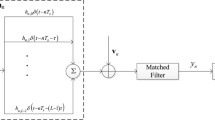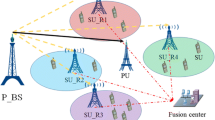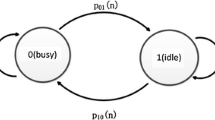Abstract
Cognitive radio, as an important means of implementing spectrum-awareness and dynamic sharing, is of great significance to the future deployment of self-organizing networks. Given its practical application, cognitive radio technology may operate in various adverse self-organizing networks environments. For example, in wireless mobile communication, the multipath propagation with time-varying fading coefficients and unknown noise variance becomes inevitable. Unfortunately, most existing spectrum sensing methods could hardly acquire good performance in this adverse situation. To overcome this difficulty, in this paper we present a novel spectrum sensing algorithm in realistic cognitive radio applications. Firstly, we establish a dynamic state-space model which gives full consideration to the evolution characteristics of primary user’s state and time-variant multipath flat fading channel, while the received signal processed by matched filtering is viewed as the observation. On this basis, spectrum sensing is realized by estimating the primary user’s state, multipath channel impulse response and noise variance jointly and iteratively. This formulated problem is solved based on maximum a posteriori probability criterion and marginal particle filtering technology. Simulations demonstrate that the sensing performance achieved by proposed algorithm is satisfactory and at the same time, the channel response and noise variance are estimated accurately.











Similar content being viewed by others
References
Xiao JF, Hu RQ, Qian Y, Gong L et al (April 2013) Expanding LTE network spectrum with cognitive radios: from concept to implementation. IEEE Wirel Commun 20(2):12–19
Ghosh C, Roy S, Cavalcanti D (August 2011) Coexistence challenges for heterogeneous cognitive wireless networks in TV white spaces. IEEE Wirel Commun 18(4):22–31
Zhao X, Kivinen J, Vainikainen P, Skog K (Jan. 2003) Characterization of Doppler spectra for mobile communications at 5.3 GHz. IEEE Trans Veh Technol 52(1):14–23
Federal Communication Commission, Spectrum Policy Task Force Report, ET Docket,no.02-155, 02 November 2002
López-Benítez M, Casadevall F (2012) Improved energy detection spectrum sensing for cognitive radio. IET Commun 6(8):785–796
Digham FF, Alouini MS, Simon MK (2003) On the energy detection of unknown signals over fading channels. In Proc. of IEEE International Conference on Communications (ICC), Anchorage, AK, pp. 3575–357
Chen HS, Gao W, Daut DG (2007) Signature based spectrum sensing algorithms for IEEE 802.22 WRAN. In Proc. of IEEE International Conference on Communications (ICC), Glasgow, Scotland, pp. 6487–6492
Zhang Z, Yang QQ, Wang LK, Zhou XF (2010) A novel hybrid matched filter structure for IEEE 802.22 standard. In Proc. of IEEE Asia Pacific Conference on Circuits and Systems (APCCAS), Kuala Lumpur, Malaysia, pp. 652–655
Sabat SL, Srinu S, Raveendranadh A, Udgata SK (2012) Spectrum sensing based on entropy estimation using cyclostationary features for Cognitive radio. Communication Systems and Networks (COMSNETS), 2012 Fourth International Conference on, pp. 1–6
Tian Z, Giannakis GB (2007) Compressed sensing for wideband cognitive radios. In Proc. IEEE Int. Conf. Acoustics, Speech, and Signal Processing (ICASSP), Honolulu, HI, pp. 1357–1360
Zeng YH, Liang YC (2009) Eigenvalue-based spectrum sensing algorithms for cognitive radio. IEEE Trans Commun 57:1784–1793
Molisch AF (2005) Wireless communications. Wiley, Chichester
Chen D, Li J, Ma J (2008) Cooperative spectrum sensing under noise uncertainty in cognitive radio. In Proc. of Wireless Communications, Networking and Mobile Computing, Dalian, China, pp. 1–4
Song C, Alemseged YD, Tran HN et al (2010) Adaptive two thresholds based energy detection for cooperative spectrum sensing. In Proc. of Consumer Communications and Networking, Las Vegas, USA, pp. 1–6
Zhang R, Lim TJ, Liang YC, Zeng Y (2010) Multi-antenna based spectrum sensing for cognitive radios: a GLRT approach. IEEE Trans Commun 58(1):84–88
Zeng Y, Liang YC (2009) Spectrum-sensing algorithms for cognitive radio based on statistical covariances. IEEE Trans Veh Technol 58(4):1804–1815
Sadeghi P, Kennedy RA, Rapajic PB, Shams R (2008) Finite-state Markov modeling of fading channels. IEEE Signal Proc Mag 25(5):57–80
Li B, Zhao CL, Sun MW, Nallanathan A (2014) Spectrum sensing for cognitive radios in time-variant flat fading channels: a joint estimation approach. IEEE Trans Commun 62(8):2665–2680
Theodore S (2005) Rappaport, wireless communications: principles and practice, 2nd edn. Prentice Hall, New Jersey
Sun MW, Li B, Song Q, Zhao L, Zhao CL (2014) Joint detection scheme for spectrum sensing over time-variant flat fading channels. IET Commun 8(12):2064–2073
Ma J, Li GY, Juang BH (May 2009) Signal processing in cognitive radio. Proc IEEE 97(5):805–823
Lu L, Zhou XW, Onunkwo U, Li GY (2012) Ten years of cognitive radio technology. EURASIP J Wirel Commun Netw 28:1–16
Li B, Sun MW, Li XF, Nallanathan A, Zhao CL (2014) Energy detection based spectrum sensing for cognitive radios over time-frequency doubly selective fading channels. IEEE Trans Signal Process 63(2):402–417
Djuric PM, Kotecha JH, Zhang JQ et al (2003) Particle filtering. IEEE Signal Proc Mag 20(5):19–38
Saha S, Ozkan E, Gustafsson F, Šmídl V (2010) Marginalized particle filters for Bayesian estimation of Gaussian noise parameters. In Proc. 2010 13th Conference on Information Fusion (FUSION), Edinburgh, UK
Joaquin M, Djuric PM (2004) Blind equalization of frequency-selective channels by sequential importance sampling. IEEE Trans Signal Proc 52(10):2738–2748
Acknowledgments
This work was supported by the National Natural Science Foundation of China (61379016, 61471061) and Postgraduate Innovation Fund of SICE, BUPT, 2015.
Author information
Authors and Affiliations
Corresponding author
Appendix 1. Posterior probability of TVMFF channel gain
Appendix 1. Posterior probability of TVMFF channel gain
On the condition that the result of coarse detection is in active state and the proposed accumulative modification mechanism, the posterior probability of h n could be represented as:
Based on the conditional probability p(B|A)=p(AB)/p(A), we could rewrite (1-A) as:
The observation Y n is only associated with the channel gain, the PU state in n-th sensing slot and the L n , thus, the simplification could be performed as:
Furthermore, the channel gain and the PU state are independent with each other, thus:
In combination, the Eq. (2-A) could be simplified as:
Rights and permissions
About this article
Cite this article
Sun, M., Li, S., Li, B. et al. Spectrum Sensing for Self-Organizing Network in the Presence of Time-Variant Multipath Flat Fading Channels and Unknown Noise Variance. Mobile Netw Appl 20, 435–448 (2015). https://doi.org/10.1007/s11036-015-0638-8
Published:
Issue Date:
DOI: https://doi.org/10.1007/s11036-015-0638-8




